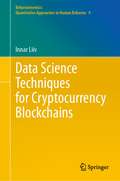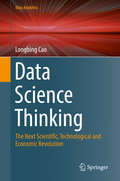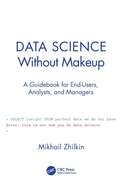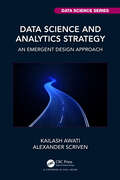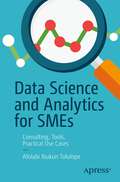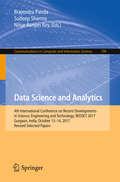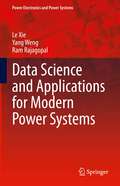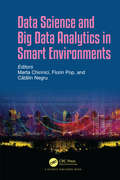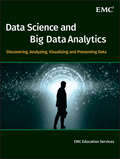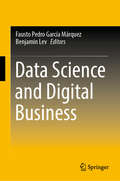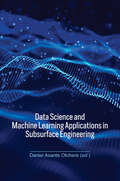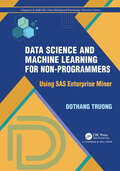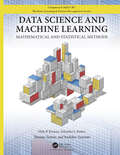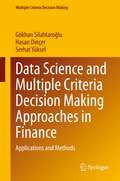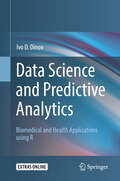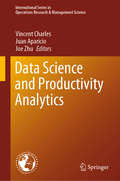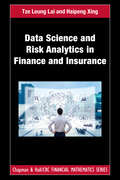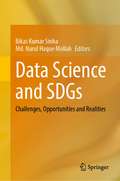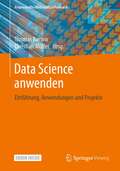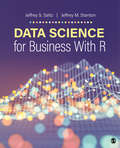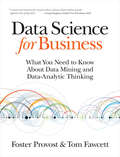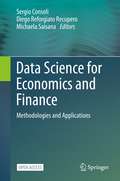- Table View
- List View
Data Science Techniques for Cryptocurrency Blockchains
by Innar LiivThis book brings together two major trends: data science and blockchains. It is one of the first books to systematically cover the analytics aspects of blockchains, with the goal of linking traditional data mining research communities with novel data sources. Data science and big data technologies can be considered cornerstones of the data-driven digital transformation of organizations and society. The concept of blockchain is predicted to enable and spark transformation on par with that associated with the invention of the Internet. Cryptocurrencies are the first successful use case of highly distributed blockchains, like the world wide web was to the Internet. <P><P> The book takes the reader through basic data exploration topics, proceeding systematically, method by method, through supervised and unsupervised learning approaches and information visualization techniques, all the way to understanding the blockchain data from the network science perspective. <P><P> Chapters introduce the cryptocurrency blockchain data model and methods to explore it using structured query language, association rules, clustering, classification, visualization, and network science. Each chapter introduces basic concepts, presents examples with real cryptocurrency blockchain data and offers exercises and questions for further discussion. Such an approach intends to serve as a good starting point for undergraduate and graduate students to learn data science topics using cryptocurrency blockchain examples. It is also aimed at researchers and analysts who already possess good analytical and data skills, but who do not yet have the specific knowledge to tackle analytic questions about blockchain transactions. The readers improve their knowledge about the essential data science techniques in order to turn mere transactional information into social, economic, and business insights.
Data Science Thinking: The Next Scientific, Technological and Economic Revolution (Data Analytics)
by Longbing CaoThis book explores answers to the fundamental questions driving the research, innovation and practices of the latest revolution in scientific, technological and economic development: how does data science transform existing science, technology, industry, economy, profession and education? How does one remain competitive in the data science field? What is responsible for shaping the mindset and skillset of data scientists? Data Science Thinking paints a comprehensive picture of data science as a new scientific paradigm from the scientific evolution perspective, as data science thinking from the scientific-thinking perspective, as a trans-disciplinary science from the disciplinary perspective, and as a new profession and economy from the business perspective. The topics cover an extremely wide spectrum of essential and relevant aspects of data science, spanning its evolution, concepts, thinking, challenges, discipline, and foundation, all the way to industrialization, profession, education, and the vast array of opportunities that data science offers. The book's three parts each detail layers of these different aspects. The book is intended for decision-makers, data managers (e.g., analytics portfolio managers, business analytics managers, chief data analytics officers, chief data scientists, and chief data officers), policy makers, management and decision strategists, research leaders, and educators who are responsible for pursuing new scientific, innovation, and industrial transformation agendas, enterprise strategic planning, a next-generation profession-oriented course development, as well as those who are involved in data science, technology, and economy from an advanced perspective. Research students in data science-related courses and disciplines will find the book useful for positing their innovative scientific journey, planning their unique and promising career, and competing within and being ready for the next generation of science, technology, and economy.
Data Science Without Makeup: A Guidebook for End-Users, Analysts, and Managers
by Mikhail Zhilkin"Having worked with Mikhail it does not surprise me that he has put together a comprehensive and insightful book on Data Science where down-to-earth pragmatism is the recurring theme. This is a must-read for everyone interested in industrial data science, in particular analysts and managers who want to learn from Mikhail‘s great experience and approach." --Stefan Freyr Gudmundsson, Lead Data Scientist at H&M, former AI Research Lead at King and Director of Risk Analytics and Modeling at Islandsbanki. "It tells the unvarnished truth about data science. Chapter 2 ("Data Science is Hard") is worth the price on its own—and then Zhilkin gives us processes to help. A must-read for any practitioner, manager, or executive sponsor of data science." --Ted Lorenzen, Director of Marketing Analytics at Vein Clinics of America "Mikhail is a pioneer in the applied data science space. His ability to provide innovative solutions to practical questions in a dynamic environment is simply superb. Importantly, Mikhail’s ability to remain calm and composed in high-pressure situations is surpassed only by his humility." --Darren Burgess, High Performance Manager at Melbourne FC, former Head of Elite Performance at Arsenal FC Mikhail Zhilkin, a data scientist who has worked on projects ranging from Candy Crush games to Premier League football players’ physical performance, shares his strong views on some of the best and, more importantly, worst practices in data analytics and business intelligence. Why data science is hard, what pitfalls analysts and decision-makers fall into, and what everyone involved can do to give themselves a fighting chance—the book examines these and other questions with the skepticism of someone who has seen the sausage being made. Honest and direct, full of examples from real life, Data Science Without Makeup: A Guidebook for End-Users, Analysts and Managers will be of great interest to people who aspire to work with data, people who already work with data, and people who work with people who work with data—from students to professional researchers and from early-career to seasoned professionals. Mikhail Zhilkin is a data scientist at Arsenal FC. He has previously worked on the popular Candy Crush mobile games and in sports betting.
Data Science and Analytics Strategy: An Emergent Design Approach (Chapman & Hall/CRC Data Science Series)
by Kailash Awati Alexander ScrivenThis book describes how to establish data science and analytics capabilities in organisations using Emergent Design, an evolutionary approach that increases the chances of successful outcomes while minimising upfront investment. Based on their experiences and those of a number of data leaders, the authors provide actionable advice on data technologies, processes, and governance structures so that readers can make choices that are appropriate to their organisational contexts and requirements. The book blends academic research on organisational change and data science processes with real-world stories from experienced data analytics leaders, focusing on the practical aspects of setting up a data capability. In addition to a detailed coverage of capability, culture, and technology choices, a unique feature of the book is its treatment of emerging issues such as data ethics and algorithmic fairness. Data Science and Analytics Strategy: An Emergent Design Approach has been written for professionals who are looking to build data science and analytics capabilities within their organisations as well as those who wish to expand their knowledge and advance their careers in the data space. Providing deep insights into the intersection between data science and business, this guide will help professionals understand how to help their organisations reap the benefits offered by data. Most importantly, readers will learn how to build a fit-for-purpose data science capability in a manner that avoids the most common pitfalls.
Data Science and Analytics for SMEs: Consulting, Tools, Practical Use Cases
by Afolabi Ibukun TolulopeMaster the tricks and techniques of business analytics consulting, specifically applicable to small-to-medium businesses (SMEs). Written to help you hone your business analytics skills, this book applies data science techniques to help solve problems and improve upon many aspects of a business' operations. SMEs are looking for ways to use data science and analytics, and this need is becoming increasingly pressing with the ongoing digital revolution. The topics covered in the books will help to provide the knowledge leverage needed for implementing data science in small business. The demand of small business for data analytics are in conjunction with the growing number of freelance data science consulting opportunities; hence this book will provide insight on how to navigate this new terrain.This book uses a do-it-yourself approach to analytics and introduces tools that are easily available online and are non-programming based. Data science will allow SMEs to understand their customer loyalty, market segmentation, sales and revenue increase etc. more clearly. Data Science and Analytics for SMEs is particularly focused on small businesses and explores the analytics and data that can help them succeed further in their business. What You'll LearnCreate and measure the success of their analytics projectStart your business analytics consulting careerUse solutions taught in the book in practical uses cases and problems Who This Book Is ForBusiness analytics enthusiasts who are not particularly programming inclined, small business owners and data science consultants, data science and business students, and SME (small-to-medium enterprise) analysts
Data Science and Analytics: 4th International Conference On Recent Developments In Science, Engineering And Technology, Redset 2017, Gurgaon, India, October 13-14, 2017, Revised Selected Papers (Communications In Computer And Information Science #799)
by Brajendra Panda Sudeep Sharma Nihar Ranjan RoyThis book constitutes the refereed proceedings of the 4th International Conference on Recent Developments in Science, Engineering and Technology, REDSET 2017, held in Gurgaon, India, in October 2017. The 66 revised full papers presented were carefully reviewed and selected from 329 submissions. The papers are organized in topical sections on big data analysis, data centric programming, next generation computing, social and web analytics, security in data science analytics.
Data Science and Applications for Modern Power Systems (Power Electronics and Power Systems)
by Le Xie Yang Weng Ram RajagopalThis book offers a comprehensive collection of research articles that utilize data—in particular large data sets—in modern power systems operation and planning. As the power industry moves towards actively utilizing distributed resources with advanced technologies and incentives, it is becoming increasingly important to benefit from the available heterogeneous data sets for improved decision-making. The authors present a first-of-its-kind comprehensive review of big data opportunities and challenges in the smart grid industry. This book provides succinct and useful theory, practical algorithms, and case studies to improve power grid operations and planning utilizing big data, making it a useful graduate-level reference for students, faculty, and practitioners on the future grid.
Data Science and Big Data Analytics in Smart Environments
by Marta Chinnici; Florin Pop; Cătălin NegruMost applications generate large datasets, like social networking and social influence programs, smart cities applications, smart house environments, Cloud applications, public web sites, scientific experiments and simulations, data warehouse, monitoring platforms, and e-government services. Data grows rapidly, since applications produce continuously increasing volumes of both unstructured and structured data. Large-scale interconnected systems aim to aggregate and efficiently exploit the power of widely distributed resources. In this context, major solutions for scalability, mobility, reliability, fault tolerance and security are required to achieve high performance and to create a smart environment. The impact on data processing, transfer and storage is the need to re-evaluate the approaches and solutions to better answer the user needs. A variety of solutions for specific applications and platforms exist so a thorough and systematic analysis of existing solutions for data science, data analytics, methods and algorithms used in Big Data processing and storage environments is significant in designing and implementing a smart environment.Fundamental issues pertaining to smart environments (smart cities, ambient assisted leaving, smart houses, green houses, cyber physical systems, etc.) are reviewed. Most of the current efforts still do not adequately address the heterogeneity of different distributed systems, the interoperability between them, and the systems resilience. This book will primarily encompass practical approaches that promote research in all aspects of data processing, data analytics, data processing in different type of systems: Cluster Computing, Grid Computing, Peer-to-Peer, Cloud/Edge/Fog Computing, all involving elements of heterogeneity, having a large variety of tools and software to manage them. The main role of resource management techniques in this domain is to create the suitable frameworks for development of applications and deployment in smart environments, with respect to high performance. The book focuses on topics covering algorithms, architectures, management models, high performance computing techniques and large-scale distributed systems.
Data Science and Big Data Analytics: Discovering, Analyzing, Visualizing and Presenting Data
by Emc Education ServicesData Science and Big Data Analytics is about harnessing the power of data for new insights. The book covers the breadth of activities and methods and tools that Data Scientists use. The content focuses on concepts, principles and practical applications that are applicable to any industry and technology environment, and the learning is supported and explained with examples that you can replicate using open-source software.This book will help you:Become a contributor on a data science teamDeploy a structured lifecycle approach to data analytics problemsApply appropriate analytic techniques and tools to analyzing big dataLearn how to tell a compelling story with data to drive business actionPrepare for EMC Proven Professional Data Science Certification
Data Science and Digital Business
by Fausto Pedro García Márquez Benjamin LevThis book combines the analytic principles of digital business and data science with business practice and big data. The interdisciplinary, contributed volume provides an interface between the main disciplines of engineering and technology and business administration. Written for managers, engineers and researchers who want to understand big data and develop new skills that are necessary in the digital business, it not only discusses the latest research, but also presents case studies demonstrating the successful application of data in the digital business.
Data Science and Machine Learning Applications in Subsurface Engineering
by Daniel Asante OtchereThis book covers unsupervised learning, supervised learning, clustering approaches, feature engineering, explainable AI and multioutput regression models for subsurface engineering problems. Processing voluminous and complex data sets are the primary focus of the field of machine learning (ML). ML aims to develop data-driven methods and computational algorithms that can learn to identify complex and non-linear patterns to understand and predict the relationships between variables by analysing extensive data. Although ML models provide the final output for predictions, several steps need to be performed to achieve accurate predictions. These steps, data pre-processing, feature selection, feature engineering and outlier removal, are all contained in this book. New models are also developed using existing ML architecture and learning theories to improve the performance of traditional ML models and handle small and big data without manual adjustments. This research-oriented book will help subsurface engineers, geophysicists, and geoscientists become familiar with data science and ML advances relevant to subsurface engineering. Additionally, it demonstrates the use of data-driven approaches for salt identification, seismic interpretation, estimating enhanced oil recovery factor, predicting pore fluid types, petrophysical property prediction, estimating pressure drop in pipelines, bubble point pressure prediction, enhancing drilling mud loss, smart well completion and synthetic well log predictions.
Data Science and Machine Learning for Non-Programmers: Using SAS Enterprise Miner (Chapman & Hall/CRC Data Mining and Knowledge Discovery Series)
by Dothang TruongAs data continues to grow exponentially, knowledge of data science and machine learning has become more crucial than ever. Machine learning has grown exponentially; however, the abundance of resources can be overwhelming, making it challenging for new learners. This book aims to address this disparity and cater to learners from various non-technical fields, enabling them to utilize machine learning effectively. Adopting a hands-on approach, readers are guided through practical implementations using real datasets and SAS Enterprise Miner, a user-friendly data mining software that requires no programming. Throughout the chapters, two large datasets are used consistently, allowing readers to practice all stages of the data mining process within a cohesive project framework. This book also provides specific guidelines and examples on presenting data mining results and reports, enhancing effective communication with stakeholders. Designed as a guiding companion for both beginners and experienced practitioners, this book targets a wide audience, including students, lecturers, researchers, and industry professionals from various backgrounds.
Data Science and Machine Learning: Mathematical and Statistical Methods (Chapman And Hall/crc Machine Learning And Pattern Recognition Ser.)
by Dirk P. Kroese Thomas Taimre Radislav Vaisman Zdravko Botev"This textbook is a well-rounded, rigorous, and informative work presenting the mathematics behind modern machine learning techniques. It hits all the right notes: the choice of topics is up-to-date and perfect for a course on data science for mathematics students at the advanced undergraduate or early graduate level. This book fills a sorely-needed gap in the existing literature by not sacrificing depth for breadth, presenting proofs of major theorems and subsequent derivations, as well as providing a copious amount of Python code. I only wish a book like this had been around when I first began my journey!" -Nicholas Hoell, University of Toronto "This is a well-written book that provides a deeper dive into data-scientific methods than many introductory texts. The writing is clear, and the text logically builds up regularization, classification, and decision trees. Compared to its probable competitors, it carves out a unique niche. -Adam Loy, Carleton College The purpose of Data Science and Machine Learning: Mathematical and Statistical Methods is to provide an accessible, yet comprehensive textbook intended for students interested in gaining a better understanding of the mathematics and statistics that underpin the rich variety of ideas and machine learning algorithms in data science. Key Features: Focuses on mathematical understanding. Presentation is self-contained, accessible, and comprehensive. Extensive list of exercises and worked-out examples. Many concrete algorithms with Python code. Full color throughout. Further Resources can be found on the authors website: https://github.com/DSML-book/Lectures
Data Science and Multiple Criteria Decision Making Approaches in Finance: Applications and Methods (Multiple Criteria Decision Making)
by Hasan Dinçer Serhat Yüksel Gökhan SilahtaroğluThis book considers and assesses essential financial issues by utilizing data science and fuzzy multiple criteria decision making (MCDM) methods. It introduces readers to a range of data science methods, and demonstrates their application in the fields of business, health, economics, finance and engineering. In addition, it provides suggestions based on the assessment results on each topic, which can help to enhance the efficiency of the financial system and the sustainability of economic development. Given its scope, the book will help readers broaden their perspective on the assessment and evaluation of financial issues using data science and MCDM approaches.
Data Science and Predictive Analytics: Biomedical And Health Applications Using R
by Ivo D. DinovOver the past decade, Big Data have become ubiquitous in all economic sectors, scientific disciplines, and human activities. They have led to striking technological advances, affecting all human experiences. Our ability to manage, understand, interrogate, and interpret such extremely large, multisource, heterogeneous, incomplete, multiscale, and incongruent data has not kept pace with the rapid increase of the volume, complexity and proliferation of the deluge of digital information. There are three reasons for this shortfall. First, the volume of data is increasing much faster than the corresponding rise of our computational processing power (Kryder’s law > Moore’s law). Second, traditional discipline-bounds inhibit expeditious progress. Third, our education and training activities have fallen behind the accelerated trend of scientific, information, and communication advances. There are very few rigorous instructional resources, interactive learning materials, and dynamic training environments that support active data science learning. The textbook balances the mathematical foundations with dexterous demonstrations and examples of data, tools, modules and workflows that serve as pillars for the urgently needed bridge to close that supply and demand predictive analytic skills gap. Exposing the enormous opportunities presented by the tsunami of Big data, this textbook aims to identify specific knowledge gaps, educational barriers, and workforce readiness deficiencies. Specifically, it focuses on the development of a transdisciplinary curriculum integrating modern computational methods, advanced data science techniques, innovative biomedical applications, and impactful health analytics. The content of this graduate-level textbook fills a substantial gap in integrating modern engineering concepts, computational algorithms, mathematical optimization, statistical computing and biomedical inference. Big data analytic techniques and predictive scientific methods demand broad transdisciplinary knowledge, appeal to an extremely wide spectrum of readers/learners, and provide incredible opportunities for engagement throughout the academy, industry, regulatory and funding agencies. The two examples below demonstrate the powerful need for scientific knowledge, computational abilities, interdisciplinary expertise, and modern technologies necessary to achieve desired outcomes (improving human health and optimizing future return on investment). This can only be achieved by appropriately trained teams of researchers who can develop robust decision support systems using modern techniques and effective end-to-end protocols, like the ones described in this textbook. • A geriatric neurologist is examining a patient complaining of gait imbalance and posture instability. To determine if the patient may suffer from Parkinson’s disease, the physician acquires clinical, cognitive, phenotypic, imaging, and genetics data (Big Data). Most clinics and healthcare centers are not equipped with skilled data analytic teams that can wrangle, harmonize and interpret such complex datasets. A learner that completes a course of study using this textbook will have the competency and ability to manage the data, generate a protocol for deriving biomarkers, and provide an actionable decision support system. The results of this protocol will help the physician understand the entire patient dataset and assist in making a holistic evidence-based, data-driven, clinical diagnosis.• To improve the return on investment for their shareholders, a healthcare manufacturer needs to forecast the demand for their product subject to environmental, demographic, economic, and bio-social sentiment data (Big Data). The organization’s data-analytics team is tasked with developing a protocol that identifies, aggregates, harmonizes, models and analyzes these heterogeneous data elements to generate a trend forecast. This system needs to provide an automated, adaptive, scalable, and reliable prediction of the optimal investment, e.g., R&D allocation, that maximizes the company’s bot
Data Science and Productivity Analytics (International Series in Operations Research & Management Science #290)
by Joe Zhu Juan Aparicio Vincent CharlesThis book includes a spectrum of concepts, such as performance, productivity, operations research, econometrics, and data science, for the practically and theoretically important areas of ‘productivity analysis/data envelopment analysis’ and ‘data science/big data’. Data science is defined as the collection of scientific methods, processes, and systems dedicated to extracting knowledge or insights from data and it develops on concepts from various domains, containing mathematics and statistical methods, operations research, machine learning, computer programming, pattern recognition, and data visualisation, among others. Examples of data science techniques include linear and logistic regressions, decision trees, Naïve Bayesian classifier, principal component analysis, neural networks, predictive modelling, deep learning, text analysis, survival analysis, and so on, all of which allow using the data to make more intelligent decisions. On the other hand, it is without a doubt that nowadays the amount of data is exponentially increasing, and analysing large data sets has become a key basis of competition and innovation, underpinning new waves of productivity growth. This book aims to bring a fresh look onto the various ways that data science techniques could unleash value and drive productivity from these mountains of data.Researchers working in productivity analysis/data envelopment analysis will benefit from learning about the tools available in data science/big data that can be used in their current research analyses and endeavours. The data scientists, on the other hand, will also get benefit from learning about the plethora of applications available in productivity analysis/data envelopment analysis.
Data Science and Risk Analytics in Finance and Insurance (Chapman and Hall/CRC Financial Mathematics Series)
by Tze Leung Lai Haipeng XingThis book presents statistics and data science methods for risk analytics in quantitative finance and insurance. Part I covers the background, financial models, and data analytical methods for market risk, credit risk, and operational risk in financial instruments, as well as models of risk premium and insolvency in insurance contracts. Part II provides an overview of machine learning (including supervised, unsupervised, and reinforcement learning), Monte Carlo simulation, and sequential analysis techniques for risk analytics. In Part III, the book offers a non-technical introduction to four key areas in financial technology: artificial intelligence, blockchain, cloud computing, and big data analytics.Key Features: Provides a comprehensive and in-depth overview of data science methods for financial and insurance risks. Unravels bandits, Markov decision processes, reinforcement learning, and their interconnections. Promotes sequential surveillance and predictive analytics for abrupt changes in risk factors. Introduces the ABCDs of FinTech: Artificial intelligence, blockchain, cloud computing, and big data analytics. Includes supplements and exercises to facilitate deeper comprehension.
Data Science and SDGs: Challenges, Opportunities and Realities
by Bikas Kumar Sinha Md. Nurul Haque MollahThe book presents contributions on statistical models and methods applied, for both data science and SDGs, in one place. Measuring and controlling data of SDGs, data driven measurement of progress needs to be distributed to stakeholders. In this situation, the techniques used in data science, specially, in the big data analytics, play an important role rather than the traditional data gathering and manipulation techniques. This book fills this space through its twenty contributions. The contributions have been selected from those presented during the 7th International Conference on Data Science and Sustainable Development Goals organized by the Department of Statistics, University of Rajshahi, Bangladesh; and cover topics mainly on SDGs, bioinformatics, public health, medical informatics, environmental statistics, data science and machine learning. The contents of the volume would be useful to policymakers, researchers, government entities, civil society, and nonprofit organizations for monitoring and accelerating the progress of SDGs.
Data Science anwenden: Einführung, Anwendungen und Projekte (Angewandte Wirtschaftsinformatik)
by Thomas Barton Christian MüllerDieses Buch bietet einen Einstieg in das Thema Data Science auf Basis der visuellen Aufbereitung von Daten. Es hat ethische Betrachtungen in der digitalen Transformation zum Gegenstand und stellt ein Prozessrahmenwerk für die Bewertung von Technologien vor. Außerdem erläutert es Besonderheiten und Erkenntnisse zum Scheitern von Data-Science-Projekten und stellt Empfehlungssysteme unter Berücksichtigung aktueller Entwicklungen vor. Funktionalität zu Machine Learning in Werkzeugen zu Business Analytics wird verglichen und der Einsatz eines Vorgehensmodells für Data Science aufgezeigt.Die Integration erneuerbarer Energien am Beispiel von Photovoltaikanlagen, ein effizienterer Umgang mit Wärmeenergie, wissenschaftliche Literaturauswertung, Kundenzufriedenheit in der Automobilindustrie und ein Framework für die Analyse von Fahrzeugdaten dienen als Anwendungsbeispiele für den konkreten Einsatz von Data Science. Das Buch bietet wichtige Informationen, die für Praktiker ebenso relevant sind wie für Studierende und Lehrende.
Data Science at Target
by Srikant M. Datar Caitlin N. Bowler<p>Paritosh Desai joined Target.com in 2013 as VP of Business Intelligence, Analytics & Testing to explore how the retailer could use its relatively small but thriving e-commerce arm to drive sales and win customers. The case explores the technological and organizational challenges Desai faced and the trade offs he considered in his four-year journey to develop the larger retail business into a data science organization. <p>Professor Srikant M. Datar and Research Associate Caitlin N. Bowler prepared this case. It was reviewed and approved before publication by a company designate. Funding for the development of this case was provided by Harvard Business School and not by the company. The citation review for this case has not yet been completed. HBS cases are developed solely as the basis for class discussion. Cases are not intended to serve as endorsements, sources of primary data, or illustrations of effective or ineffective management.</p>
Data Science at the Warriors
by Michael Parzen Iavor BojinovAn introductory case for a data science course, which provides an overview of the data science pipeline.
Data Science for Business With R
by Jeffrey S. Saltz Jeffrey Morgan StantonData Science for Business with R, written by Jeffrey S. Saltz and Jeffrey M. Stanton, focuses on the concepts foundational for students starting a business analytics or data science degree program. To keep the book practical and applied, the authors feature a running case using a global airline business’s customer survey dataset to illustrate how to turn data in business decisions, in addition to numerous examples throughout. To aid in usability beyond the classroom, the text features full integration of freely-available R and RStudio software, one of the most popular data science tools available. Designed for students with little to no experience in related areas like computer science, the book chapters follow a logical order from introduction and installation of R and RStudio, working with data architecture, undertaking data collection, performing data analysis, and transitioning to data archiving and presentation. Each chapter follows a familiar structure, starting with learning objectives and background, following the basic steps of functions alongside simple examples, applying these functions to the case study, and ending with chapter challenge questions, sources, and a list of R functions so students know what to expect in each step of their data science course. Data Science for Business with R provides readers with a straightforward and applied guide to this new and evolving field.
Data Science for Business With R
by Jeffrey S. Saltz Jeffrey Morgan StantonData Science for Business with R, written by Jeffrey S. Saltz and Jeffrey M. Stanton, focuses on the concepts foundational for students starting a business analytics or data science degree program. To keep the book practical and applied, the authors feature a running case using a global airline business’s customer survey dataset to illustrate how to turn data in business decisions, in addition to numerous examples throughout. To aid in usability beyond the classroom, the text features full integration of freely-available R and RStudio software, one of the most popular data science tools available. Designed for students with little to no experience in related areas like computer science, the book chapters follow a logical order from introduction and installation of R and RStudio, working with data architecture, undertaking data collection, performing data analysis, and transitioning to data archiving and presentation. Each chapter follows a familiar structure, starting with learning objectives and background, following the basic steps of functions alongside simple examples, applying these functions to the case study, and ending with chapter challenge questions, sources, and a list of R functions so students know what to expect in each step of their data science course. Data Science for Business with R provides readers with a straightforward and applied guide to this new and evolving field.
Data Science for Business: What You Need to Know about Data Mining and Data-Analytic Thinking
by Tom Fawcett Foster ProvostWritten by renowned data science experts Foster Provost and Tom Fawcett, Data Science for Business introduces the fundamental principles of data science, and walks you through the "data-analytic thinking" necessary for extracting useful knowledge and business value from the data you collect. This guide also helps you understand the many data-mining techniques in use today.Based on an MBA course Provost has taught at New York University over the past ten years, Data Science for Business provides examples of real-world business problems to illustrate these principles. You’ll not only learn how to improve communication between business stakeholders and data scientists, but also how participate intelligently in your company’s data science projects. You’ll also discover how to think data-analytically, and fully appreciate how data science methods can support business decision-making.Understand how data science fits in your organization—and how you can use it for competitive advantageTreat data as a business asset that requires careful investment if you’re to gain real valueApproach business problems data-analytically, using the data-mining process to gather good data in the most appropriate wayLearn general concepts for actually extracting knowledge from dataApply data science principles when interviewing data science job candidates
Data Science for Economics and Finance: Methodologies and Applications
by Diego Reforgiato Recupero Sergio Consoli Michaela SaisanaThis open access book covers the use of data science, including advanced machine learning, big data analytics, Semantic Web technologies, natural language processing, social media analysis, time series analysis, among others, for applications in economics and finance. In addition, it shows some successful applications of advanced data science solutions used to extract new knowledge from data in order to improve economic forecasting models. The book starts with an introduction on the use of data science technologies in economics and finance and is followed by thirteen chapters showing success stories of the application of specific data science methodologies, touching on particular topics related to novel big data sources and technologies for economic analysis (e.g. social media and news); big data models leveraging on supervised/unsupervised (deep) machine learning; natural language processing to build economic and financial indicators; and forecasting and nowcasting of economic variables through time series analysis. This book is relevant to all stakeholders involved in digital and data-intensive research in economics and finance, helping them to understand the main opportunities and challenges, become familiar with the latest methodological findings, and learn how to use and evaluate the performances of novel tools and frameworks. It primarily targets data scientists and business analysts exploiting data science technologies, and it will also be a useful resource to research students in disciplines and courses related to these topics. Overall, readers will learn modern and effective data science solutions to create tangible innovations for economic and financial applications.
